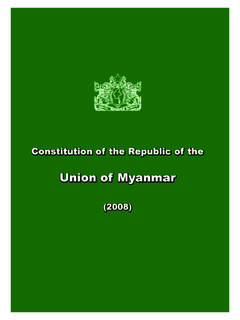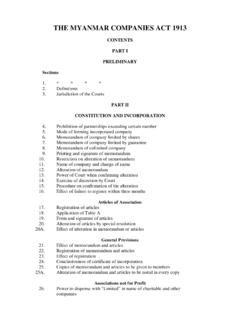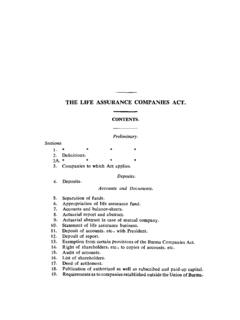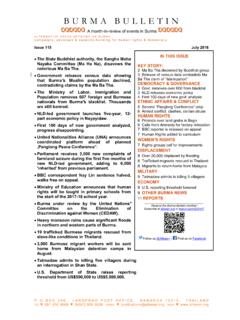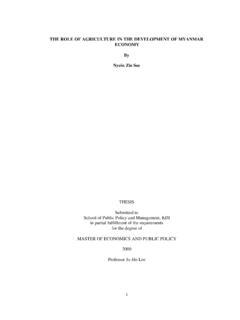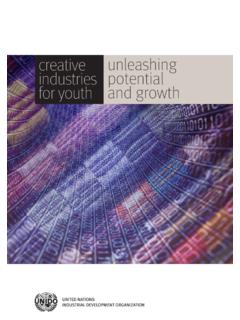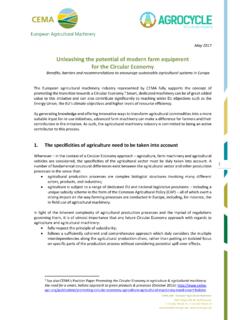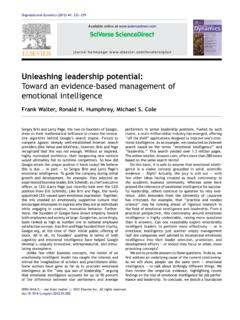Transcription of Unleashing the potential of community forest enterprises ...
1 Kyaw Tint, Oliver Springate-Baginski, Duncan Macqueen and Mehm Ko Ko GyiUnleashing the potential of community forest enterprises in MyanmarUnleashing the potential of community forest enterprises in MyanmarKyaw Tint, Oliver Springate-Baginski, Duncan Macqueen and Mehm Ko Ko GyiCitation: Kyaw Tint, Springate-Baginski, O., Macqueen, , and Mehm Ko Ko Gyi (2 014) . Unleashing the potential of community forest enterprises in Myanmar. Ecosystem Conservation and community Development Initiative (ECCDI), University of East Anglia (UEA) and International Institute for Environment and Development (IIED), London, UK. Copyright: International Institute for Environment and Development, 2014 Product code: 13571 IIEDIS BN: 978-1-784 31- 032-5 Cover photo: Woman farmer extracting produce from community forest area, Kachin State, Myanmar.
2 Duncan MacqueenDesign by: Eileen Higgins, email: Printed by Full Spectrum Print Media, UK on 100% recycled paper using vegetable oil based Dr. Kyaw Tint is Professor of Forestry and former Director-General of the forest Department, Republic of the Union of Myanmar; chairman of the Ecosystem Conservation and community Development Initiative (ECCDI); and chairman of the Myanmar Environmental Rehabilitation-conservation Network (MERN). Email: Oliver Springate-Baginski is a lecturer at the School of International Development, the University of East Anglia, United Kingdom. Email: Macqueen is a Principal Researcher at the International Institute for Environment and Development, United Kingdom. Email: Ko Ko Gyi is a retired Director of the forest Department of Myanmar; currently the first Vice-Chairman of the ECCDI.
3 Email: summary1. The Myanmar context for small forest enterprises Myanmar s extensive forest cover is an economic opportunity forest loss presents a threat to that potential The decline in forest sector importance can be reversed Historic socioeconomic under-development must be tackled Democratisation is bringing economic opportunity to forest communities How to promote community forest enterprises in Myanmar2 community forest enterprise potential and product type by region Introduction The Ayeyarwady Delta Region Mandalay Region Shan State Kachin State Overall summary3 High potential of community forest enterprises across multiple products The scale of ambition should increase Key forest products can be developed Regional
4 enterprise clusters are the way forward4 community forest enterprise development installing a market-led approach The historical policy context is now changing fast Constraints to community forest enterprise can be overcome More integrated promotion of community forest enterprise is necessary Producer group coordination must be encouraged5 Business development and finance service issues Business development services for small and medium enterprises are emerging Financial services exist but need to be more accessible Insurance and the use of forest land as collateral is required Export is possible but procedures still need simplificationReferencesAppendix 1: Field survey designAppendix 2: Local NGOs working in community forest enterprise development in 1: forest and other land use extent in Myanmar, 2010 Table 2: Value of net output of different sectors in Myanmar, 2009-2010 Table 3: The distribution of CFs in Ayeyarwady RegionTable 4: Description of CFs/FUGs visited in the deltaTable 5: Status of demand for forest products per month at local markets, Ayeyarwady RegionTable 6: CF products and enterprises suggested by villagersTable 7: Livelihoods in Bagan-Nyaung Oo Township (number of households)Table 8: Livelihoods in Pyin Oo Lwin Township (number of households)Table 9 CFs in Mandalay RegionTable 10: Description of CFs/FUGs visited in Mandalay RegionTable 11.
5 Household consumption of forest products per year and estimated cost, Mandalay RegionTable 12: Status of demand for forest products per month at local markets, Mandalay RegionTable 13: Favoured products and potential enterprise ideas in MandalayTable 14: Livelihoods in Nyaungshwe Township (number of households)Table 15: Livelihoods in Ywangan Township (number of households)Table 16: Distribution of CFs in Shan StateTable 17: Description of CFs/FUGs visited in Shan StateTable 18: Household consumption of forest products per year and estimated cost, Shan StateTable 19: Status of demand for forest products per month at local markets, Shan StateTable 20: CF products and enterprises suggested by villagersTable 21: Distribution of CFs in Kachin StateTable 22: Description of CFUGs visited in Kachin StateTable 23: Livelihoods in Waingmaw (number of households)Table 24: Livelihoods in Mohnyin (number of households)Table 25: Household consumption of forest products per year and estimated cost, Kachin StateTable 26: Status of demand for forest products per month at local markets, Kachin StateTable 27: CF products and enterprises most favoured by villagersTable 28: Priority enterprise development options by state/regionTable 29: Projected expansion of CF area in line with Government Master Plan targetTable 30: Projected CF area by State/Region and CFUG membership for a more ambitious target for CFTable 31.
6 Key forest product production figures and revenues (2009-2010)Table 32: Domestic consumption of teak (2009-2010)Table 33: Estimated production of firewood and charcoal in recent yearsTable 34: Details of current REDD+ projects in Myanmar Table 35: Challenges and strategic directions for CF enterprise developmentTable 36: Educational status of FUG membersTable 37: Classification of SMEs in MyanmarTable 38: Total number of industries and SMEs in Myanmar in 2013 Table 39: Number of cooperative societies in 2012 Table 40: Members or member societies in various levels of cooperative societies (2012)Table 41: Commercial banks established in MyanmarTable 42: Microfinance institutions operating in MyanmarTable 43: Documentary requirements for the export of products from 1: Change of forest cover in Myanmar from 1997 to 2011 Figure 2: Sources of income in four case study communities in Ayeyarwady (informal being mainly fuelwood cutters)Figure 3: Value of purchased forest products in sample villages (yearly)Figure 4: Value of forest products consumed per household per year, by study villageFigure 5: Estimated monthly values of forest products traded in urban markets, AyeyarwadyFigure 6: Composition of income generation activities in two case study villages in MandalayFigure 8: Cost of each product by percentage of total costFigure 10: Main income sources for Nyaungshwe and Ywangan Figure 13.
7 Main sources of income for households in Waingmaw and MohnyinFigure 16: Production of rattan in thousands in MyanmarFigure 17: Myanmar forest Master Plan targets for firewood productionMapsMap 1: Myanmar forest coverMap 2: Myanmar map showing locations of surveyed Benefit-cost ratioBDA Border Areas Development AssociationCDI Department of Cottage IndustriesCDM Clean Development MechanismCF community ForestCFI community Forestry InstructionCFUG community forest User GroupCSO Central Statistical OrganizationDNA Designated National AuthorityECCDI Ecosystem Conservation and community Development InitiativeFAO Food and Agriculture Organization of the United NationsFD forest Department of MyanmarFRI forest Research InstituteFUG forest User GroupGIZ German Agency for International CooperationIIED International Institute for Environment and DevelopmentIRR Internal Rate of ReturnLIFT Livelihoods and Food Security Trust FundMADB Myanmar Agriculture Development
8 Bank MEB Myanma Economic BankMMK Myanmar KyatsMOECAF Ministry of Environmental Conservation and ForestryMSL Mean Sea LevelMTE Myanmar Timber EnterpriseNFUM National Federation of forest User Groups in MyanmarNGO Non-governmental organisationNPT Nay Pyi TawNTFP Non-Timber forest ProductPFE Permanent forest EstatePOL Pyin Oo LwinPPF Protected Public ForestRECOFTC Regional community Forestry Training CentreREDD+ Reducing Emissions from Deforestation and forest Degradation; conservation, sustainable forest management and enhancement of carbon stocks RF Reserved ForestSLORC State Law and Order Restoration CouncilSMFE Small and medium forest enterprisesUNFCCC United Nations Framework Convention on Climate Change UMFCCI Union of Myanmar Federation of Chambers of Commerce and IndustryUNIDO United Nations Industrial Development book is the final output of a project which has involved a wide range of people all of whom the authors would like to thank and foremost, we are grateful to all of the local people in the study areas who so generously cooperated with us, putting in time and effort to help us better understand local realities.
9 We especially thank the members of the forest User Groups who have become Myanmar s first generation of community forestry also wish to thank the local- and national-level stakeholders in forest enterprises and the government forest department, all of whom have supported the work in so many also wish to thank the field research teams who conducted the interviews and collected to Professor Dr. Yu Pa and his team for their involvement in data collection and to our close friends, supporters and allies at the Pyoe Pin Programme, Salai Cung Lian Thawng and Gerry Fox. Thanks to the IIED and the forest Connect to Rodd Myers and Jeremias Schmid for their help and inputs with specific forest , many thanks to the UK Government s Department for International Development (DFID) and the Swedish International Development Agency (Sida) for financial support for this summaryUnleashing the potential of community forest (CF) enterprise in Myanmar is crucial for two main reasons.
10 First, it will increase local incomes and government revenues, which will reduce poverty. Second, the financial incentive of such enterprises will encourage local people to manage and restore forests. Without enlisting the help of rural communities in these efforts it is likely that forest loss will continue and the contribution of forests to the rural economy will continue to decline. The rate of forest loss in Myanmar is among the highest in the world, running at per cent per year between 2000 and 2010. The forest sector s importance to the overall economy has declined in this time, from per cent in 2006-2007 to per cent in 2010-2011. Myanmar s overall economy is now beginning to grow but at least 26 per cent of the population remain in poverty mostly in rural areas.
